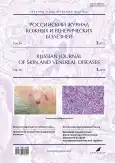Распространённость, клинико-эпидемиологические особенности акне и морфофункциональные характеристики кожи пациентов в возрасте 18–25 лет
- Авторы: Александрова О.А.1, Дубенский В.В.1, Дубенский В.В.1, Некрасова Е.Г.1, Шнейдер В.Э.1
-
Учреждения:
- Тверской государственный медицинский университет
- Выпуск: Том 28, № 3 (2025)
- Страницы: 301-310
- Раздел: ДЕРМАТОЛОГИЯ
- URL: https://medbiosci.ru/1560-9588/article/view/313077
- DOI: https://doi.org/10.17816/dv669784
- EDN: https://elibrary.ru/GCSVIU
- ID: 313077
Цитировать
Аннотация
Обоснование. Акне является одним из самых распространённых заболеваний кожи, которым страдают до 96% населения, однако отсутствуют современные данные о заболеваемости и клинических особенностях акне в различных возрастных группах и, в частности, у молодых людей.
Цель исследования ― оценка распространённости, клинико-эпидемиологических особенностей акне и морфофункциональных характеристик кожи у больных в возрасте 18–25 лет.
Методы. Обследовано 655 человек в возрасте 18–25 лет на наличие клинических проявлений акне. Для исследования морфофункционального состояния кожи у пациентов с тяжёлой степенью акне применялся программно-технический комплекс Multiskin Test Center MC 1000 (Courage + Khazaka electronic GmbH, Германия). Микробиом изучали с помощью бактериологического метода на обогащённых питательных средах с последующим подсчётом выросших колоний микроорганизмов (lg КОЕ/мл).
Результаты. Акне выявлено у 60,5% обследуемых. Доля мужчин среди больных составила 36,6%, женщин ― 63,4%. Превалировала лёгкая степень акне (52,7%), средняя степень тяжести диагностирована в 33,3% случаев, тяжёлая ― в 7,8%, при этом лёгкая и средняя степень тяжести преобладали у женщин, а тяжёлая ― у мужчин. Наиболее часто лёгкая степень акне встречается у женщин и мужчин в возрасте 19 лет (28,4% и 29,3%) и 21 года (30,6% и 28,0% соответственно); средняя степень акне ― в 18 лет (21,7% и 20,0% соответственно), в 19 лет (36,8% и 34,0%) и 21 год (22,6% и 24,0% соответственно); тяжёлая степень ― в 19 лет (54,5% и 30,0%) и 21 год (27,3% и 20,0% соответственно). При акне отмечаются нарушения морфофункционального состояния кожи: дегидратация, повышенная функция сальных желёз, снижение эластичности, повышенное порообразование и пигментация. На коже больных акне наблюдается изменение микробиома, характеризуемое повышением концентрации патогенных микроорганизмов (Staphylococcus aureus, Klebsiella, Enterobacter, Bacillus spp., гемолитическая форма Candida) и уменьшением условно-патогенной флоры, что способствует развитию и распространению воспалительного процесса.
Заключение. Нами восполнен пробел в современной оценке распространённости, клинико-эпидемиологических особенностей и морфофункциональных характеристик акне на российской популяции пациентов молодого возраста. Результаты исследования помогут расширить знания о патогенезе заболевания, способствуя тем самым разработке эффективного лечения и предотвращению развития осложнений.
Ключевые слова
Полный текст
Открыть статью на сайте журналаОб авторах
Ольга Александровна Александрова
Тверской государственный медицинский университет
Автор, ответственный за переписку.
Email: olgaalexandrova@live.com
ORCID iD: 0000-0001-8281-3619
SPIN-код: 8080-0721
Россия, Тверь
Валерий Викторович Дубенский
Тверской государственный медицинский университет
Email: valerydubensky@yandex.ru
ORCID iD: 0000-0002-1671-461X
SPIN-код: 3577-7335
д-р мед. наук, профессор
Россия, ТверьВладислав Валерьевич Дубенский
Тверской государственный медицинский университет
Email: dubensky.vladislav@yandex.ru
ORCID iD: 0000-0002-5583-928X
SPIN-код: 6044-8507
канд. мед. наук, профессор
Россия, ТверьЕлизавета Георгиевна Некрасова
Тверской государственный медицинский университет
Email: nekrasova-7@mail.ru
ORCID iD: 0000-0002-2805-6749
SPIN-код: 5831-5824
канд. мед. наук, доцент
Россия, ТверьВиктория Эдуардовна Шнейдер
Тверской государственный медицинский университет
Email: vishneyder22@mail.ru
ORCID iD: 0009-0005-1705-0156
SPIN-код: 3170-4732
Россия, Тверь
Список литературы
- Nast A, Dréno B, Bettoli V, et al. European evidence-based (S3) guideline for the treatment of acne - update 2016 - short version. J Eur Acad Dermatol Venereol. 2016;30(8):1261–1268. doi: 10.1111/jdv.13776
- Gollnick H, Cunliffe W, Berson D, et al. Management of acne: A report from a Global Alliance to improve outcomes in acne. J Am Acad Dermatol. 2003;49(Suppl 1): S1–37. doi: 10.1067/mjd.2003.618
- Clinical recommendations. Acne vulgar. Russian Society of Dermatovenerologists and Cosmetologists; 2020. 33 p. (In Russ.)
- Friedlander SF, Eichenfield LF, Fowler JF, et al. Acne epidemiology and pathophysiology. Semin Cutan Med Surg. 2010;(2 Suppl 1):2–4. doi: 10.1016/j.sder.2010.04.002
- Friedlander SF, Baldwin HE, Mancini AJ, et al. The acne continuum: An age-based approach to therapy. Semin Cutan Med Surg. 2011;30(3 Suppl):6–11. doi: 10.1016/j.sder.2011.07.002
- Olisova OYu. Differentiated approach to external acne therapy. Russian journal of skin and venereal diseases. 2024;27(1):55–68. doi: 10.17816/dv625969 EDN: ALOTC
- Goldsmith LA, Katz SI, Gilchrest BA, et al. Fitzpatrick’s Dermatology General Medicine. In 3 vol. Trans. from Engl. by A.V. Mishchenko, V.A. Voronenko, L.A. Galkina, et al. 2nd revised and updated. Moscow: Izd. Panfilova; 2015. (In Russ.)
- Ernandez EI, Yutskovskaya YaA. New cosmetology. Fundamentals of modern cosmetology. 2nd revised and updated. Moscow: OOO Publishing House “Kosmetika i meditsina”; 2021. 440 p. (In Russ.)
- Golousenko IYu. Late acne in women: Patients of gynecologists, endocrinologists or dermatologists? Consilium Medicum. 2021;23(8):609–611. doi: 10.26442/20751753.2021.8.201088 EDN: GETSBE
- Demina OM. Time course of changes in the indicators of phagocytosis and cell growth factors in patients with acne vulgaris during. Russian journal of Clinical dermatology and venereology. 2013;11(3):23–29. EDN: QYNPUV
- Snarskaya ES. Antibacterial therapy of vulgar acne. Vestnik dermatologii i venerologii. 2019;95(5):58–67. doi: 10.25208/0042-4609-2019-95-5-58-67 EDN: TUGPAT
- Agafonova SG, Indilova NI, Ivanova EV, et al. Noninvasive diagnostic techniques in dermatology and dermatocosmetology. Eksperimental’naya i klinicheskaya dermatokosmetologiya. 2010;(4):41–45. EDN: LNCEHC
- Barinova OA, Gallyamova YuA. Comparative study of the morphofunctional and structural characteristics of the facial skin in women of different age groups. Eksperimental’naya i klinicheskaya dermatokosmetologiya. 2012;(4):3–7. EDN: PCGOEX
Дополнительные файлы















